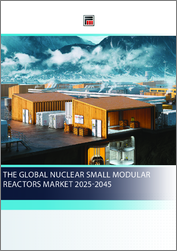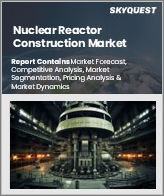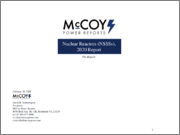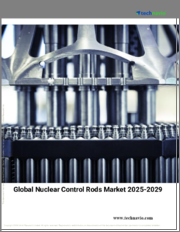
|
시장보고서
상품코드
1675417
원자로 건설 시장 : 서비스별, 노 유형별, 지역별(2025-2033년)Nuclear Reactor Construction Market Report by Service, Reactor Type, and Region 2025-2033 |
||||||
세계의 원자로 건설 시장 규모는 2024년에 73억 달러에 달했습니다. IMARC Group은 2025-2033년의 성장률(CAGR)이 2.9%로, 2033년에는 95억 달러에 달할 것으로 예측하고 있습니다. 에너지 수요의 증가, 기후변화에 대한 관심의 증가, 원자력 기술의 현저한 발전이 시장을 촉진하는 주요 요인의 일부입니다.
원자로 건설이란 원자력 발전에 필요한 부품의 건설과 조립을 수반하는 절차를 말합니다. 원자로는 핵반응을 이용하여 에너지를 생산하는 장비로, 핵에너지를 열로 변환하고 그 열을 이용하여 발전하는 장비입니다. 원자로의 건설에는 원자로 용기, 제어봉, 냉각장비, 기타 원자로를 안전하고 효율적으로 운전하기 위해 필요한 다양한 부품의 설치가 포함됩니다. 원자로 건설은 복잡하고 고도로 규제된 공정으로 광범위한 계획과 엔지니어링 전문 지식이 필요합니다. 건설에는 일반적으로 부지 준비, 설계 및 인허가, 부품 제조, 원자로 조립 등 여러 단계가 포함됩니다. 건설 과정에는 원자로가 최고의 안전 및 신뢰성 기준을 충족하도록 엄격한 안전 조치와 품질관리 프로토콜이 포함되어야 합니다.
원자로 건설 시장 동향 :
시장을 촉진하는 주요 요인 중 하나는 전 세계에서 에너지 수요가 증가하고 있다는 점입니다. 세계 인구가 계속 증가함에 따라 전력 수요는 크게 증가할 것으로 예상됩니다. 또한 원자력 발전은 특히 다른 에너지원이 제한적이거나 비용이 많이 드는 국가에서 증가하는 수요를 충족시킬 수 있는 신뢰할 수 있고 비용 효율적인 방법으로 여겨지고 있으며, 이는 시장 전망을 더욱 밝게 하고 있습니다. 이 외에도 기후 변화에 대한 우려가 높아짐에 따라 원자로 건설이 증가하고 있습니다. 이와 함께 국제 사회가 탄소 배출량 감축에 점점 더 중점을 두면서 원자력 발전에 대한 수요는 지속적으로 증가하고 있습니다. 원자력은 온실가스를 배출하지 않는 저탄소 에너지원이기 때문에 이산화탄소 배출량을 줄이려는 국가들에게 매력적인 선택이 되고 있습니다. 이 외에도 각국 정부는 청정 에너지를 촉진하고 이산화탄소 배출량을 줄이기 위해 다양한 노력을 기울이고 있습니다. 그 결과, 원자력이 이러한 목표를 달성하기 위한 전략의 중요한 요소로 간주되어 원자로 건설이 이루어지고 있습니다. 또한 각국 정부는 새로운 원자로 건설을 장려하기 위해 장려금과 보조금을 지급하고 있으며, 이는 시장 성장을 더욱 촉진하고 있습니다. 또한 원자력 기술의 눈부신 발전도 시장 성장에 기여하고 있습니다. 예를 들어 기존 원자로보다 더 안전하고 효율적이며 폐기물을 적게 배출하는 차세대 원자로가 개발되고 있습니다. 이러한 발전으로 인해 원자력 발전은 여러 국가에서 더 매력적인 선택이 되어 시장 성장에 기여하고 있습니다.
이 보고서에서 다룬 주요 질문
- 세계 원자로 건설 시장은 지금까지 어떻게 추이해 왔으며, 향후 수년간 어떻게 추이하는가?
- 세계 원자로 건설 시장 성장 촉진요인, 억제요인, 기회요인은 무엇인가?
- 각 촉진요인, 억제요인, 기회가 세계 원자로 건설 시장에 미치는 영향은?
- 주요 지역 시장은?
- 가장 매력적인 원자로 건설 시장은 어느 국가인가?
- 서비스별 시장 현황은?
- 원자로 건설 시장에서 가장 매력적인 서비스는?
- 용광로 유형별 시장 분석은?
- 원자로 건설 시장에서 가장 매력적인 원자로 유형은?
- 세계 원자로 건설 시장의 경쟁 구도는?
- 세계 원자로 건설 시장의 주요 기업은?
목차
제1장 서문
제2장 조사 범위와 조사 방법
- 조사의 목적
- 이해관계자
- 데이터 소스
- 1차 정보
- 2차 정보
- 시장 추정
- 보텀업 어프로치
- 톱다운 어프로치
- 조사 방법
제3장 개요
제4장 서론
- 개요
- 주요 업계 동향
제5장 세계의 원자로 건설 시장
- 시장 개요
- 시장 실적
- COVID-19의 영향
- 시장 예측
제6장 시장 내역 : 서비스별
- 장비
- 설치
제7장 시장 내역 : 노 유형별
- PWR·PHWR
- BWR
- HTGCR
- LMFBR
제8장 시장 내역 : 지역별
- 북미
- 미국
- 캐나다
- 아시아태평양
- 중국
- 일본
- 인도
- 한국
- 호주
- 인도네시아
- 기타
- 유럽
- 독일
- 프랑스
- 영국
- 이탈리아
- 스페인
- 러시아
- 기타
- 라틴아메리카
- 브라질
- 멕시코
- 기타
- 중동 및 아프리카
- 시장 내역 : 국가별
제9장 촉진요인·억제요인·기회
- 개요
- 촉진요인
- 억제요인
- 기회
제10장 밸류체인 분석
제11장 Porter's Five Forces 분석
- 개요
- 바이어의 교섭력
- 공급 기업의 교섭력
- 경쟁의 정도
- 신규 진출업체의 위협
- 대체품의 위협
제12장 가격 분석
제13장 경쟁 구도
- 시장 구조
- 주요 기업
- 주요 기업의 개요
- Areva S.A.
- Bilfinger SE
- Dongfang Electric Corporation
- Doosan Enerbility Co., Ltd.
- GE Hitachi Nuclear Energy(General Electric)
- KEPCO Engineering & Construction Company, Inc.(Korea Electric Power Corporation)
- Larsen & Toubro Limited
- Mitsubishi Heavy Industries Ltd
- Shanghai Electric Group Company Limited
- Siemens AG
- SKODA JS a.s.(CEZ Group)
- Westinghouse Electric Company LLC
The global nuclear reactor construction market size reached USD 7.3 Billion in 2024. Looking forward, IMARC Group expects the market to reach USD 9.5 Billion by 2033, exhibiting a growth rate (CAGR) of 2.9% during 2025-2033. The increasing demand for energy, rising concern about climate change, and significant developments in the nuclear technology represent some of the key factors driving the market.
Nuclear reactor construction refers to procedures that involve the building and assembling of components that are required to generate nuclear power. A nuclear reactor is a device that uses nuclear reactions to produce energy by converting nuclear energy into heat, which is then used to generate electricity. The construction of a nuclear reactor involves the installation of a nuclear reactor vessel, control rods, cooling systems, and various other components that are required for the safe and efficient operation of the reactor. The construction of a nuclear reactor is a complex and highly regulated process that requires extensive planning and engineering expertise. It typically involves several stages, including site preparation, design and licensing, fabrication of components, and assembly of the reactor. The construction process also involves strict safety measures and quality control protocols to ensure that the reactor is constructed to meet the highest safety and reliability standards.
Nuclear Reactor Construction Market Trends:
One of the primary factors driving the market is the increasing demand for energy across the globe. As the world population continues to grow, the demand for electricity is expected to rise significantly. Additionally, nuclear power is seen as a reliable and cost-effective way to meet this growing demand, particularly in countries where other energy sources are limited or expensive, which is further creating a positive market outlook. Other than this, with the increasing concern about climate change, there has been growing construction of nuclear reactors. Along with this, as the global community becomes increasingly focused on reducing carbon emissions, the demand for nuclear power is constantly growing as nuclear power is a low-carbon energy source that does not produce greenhouse gas emissions, making it an attractive option for countries looking to reduce their carbon footprint. Other than this, governments of different countries are undertaking various initiatives to promote clean energy and reduce carbon emissions. This resulted in the construction of nuclear reactors since nuclear power is considered a key component of their strategy for achieving these goals. Furthermore, governments are providing incentives and subsidies to encourage the construction of new nuclear reactors, further driving the market growth. Moreover, significant advancements in nuclear technology are also contributing to the market growth. For instance, next-generation nuclear reactors are being developed that are safer, more efficient, and produce less waste than traditional nuclear reactors. These advancements are making nuclear power a more attractive option for several countries, thus contributing to market growth.
Key Market Segmentation:
Service Insights:
- Equipment
- Installation
Reactor Type Insights:
- Pressurized Water Reactor (PWR) and Pressurized Heavy Water Reactor (PHWR)
- Boiling Water Reactor (BWR)
- High-temperature Gas Cooled Reactor (HTGCR)
- Liquid Metal Fast Breeder Reactor (LMFBR)
Regional Insights:
- North America
- United States
- Canada
- Europe
- Germany
- France
- United Kingdom
- Italy
- Spain
- Russia
- Others
- Asia Pacific
- China
- Japan
- India
- South Korea
- Australia
- Indonesia
- Others
- Latin America
- Brazil
- Mexico
- Others
- Middle East and Africa
- The report has also provided a comprehensive analysis of all the major regional markets, which include North America (the United States and Canada); Europe (Germany, France, the United Kingdom, Italy, Spain, and others); Asia Pacific (China, Japan, India, South Korea, Australia, Indonesia, and others); Latin America (Brazil, Mexico, and others); and the Middle East and Africa. According to the report, North America was the largest market for nuclear reactor construction. Some of the factors driving the North America nuclear reactor construction market included rising energy demand, environmental regulations, and technological advancements.
Competitive Landscape:
- The report has also provided a comprehensive analysis of the competitive landscape in the global nuclear reactor construction market. Detailed profiles of all major companies have also been provided. Some of the companies covered include Areva S.A., Bilfinger SE, Dongfang Electric Corporation, Doosan Enerbility Co., Ltd., GE Hitachi Nuclear Energy (General Electric), KEPCO Engineering & Construction Company, Inc. (Korea Electric Power Corporation), Larsen & Toubro Limited, Mitsubishi Heavy Industries Ltd, Shanghai Electric Group Company Limited, Siemens AG, SKODA JS a.s. (CEZ Group), Westinghouse Electric Company LLC, etc. Kindly note that this only represents a partial list of companies, and the complete list has been provided in the report.
Key Questions Answered in This Report:
- How has the global nuclear reactor construction market performed so far, and how will it perform in the coming years?
- What are the drivers, restraints, and opportunities in the global nuclear reactor construction market?
- What is the impact of each driver, restraint, and opportunity on the global nuclear reactor construction market?
- What are the key regional markets?
- Which countries represent the most attractive nuclear reactor construction market?
- What is the breakup of the market based on the service?
- Which is the most attractive service in the nuclear reactor construction market?
- What is the breakup of the market based on the reactor?
- Which is the most attractive reactor in the nuclear reactor construction market?
- What is the competitive structure of the global nuclear reactor construction market?
- Who are the key players/companies in the global nuclear reactor construction market?
Table of Contents
1 Preface
2 Scope and Methodology
- 2.1 Objectives of the Study
- 2.2 Stakeholders
- 2.3 Data Sources
- 2.3.1 Primary Sources
- 2.3.2 Secondary Sources
- 2.4 Market Estimation
- 2.4.1 Bottom-Up Approach
- 2.4.2 Top-Down Approach
- 2.5 Forecasting Methodology
3 Executive Summary
4 Introduction
- 4.1 Overview
- 4.2 Key Industry Trends
5 Global Nuclear Reactor Construction Market
- 5.1 Market Overview
- 5.2 Market Performance
- 5.3 Impact of COVID-19
- 5.4 Market Forecast
6 Market Breakup by Service
- 6.1 Equipment
- 6.1.1 Market Trends
- 6.1.2 Market Forecast
- 6.2 Installation
- 6.2.1 Market Trends
- 6.2.2 Market Forecast
7 Market Breakup by Reactor Type
- 7.1 Pressurized Water Reactor (PWR) and Pressurized Heavy Water Reactor (PHWR)
- 7.1.1 Market Trends
- 7.1.2 Market Forecast
- 7.2 Boiling Water Reactor (BWR)
- 7.2.1 Market Trends
- 7.2.2 Market Forecast
- 7.3 High-temperature Gas Cooled Reactor (HTGCR)
- 7.3.1 Market Trends
- 7.3.2 Market Forecast
- 7.4 Liquid Metal Fast Breeder Reactor (LMFBR)
- 7.4.1 Market Trends
- 7.4.2 Market Forecast
8 Market Breakup by Region
- 8.1 North America
- 8.1.1 United States
- 8.1.1.1 Market Trends
- 8.1.1.2 Market Forecast
- 8.1.2 Canada
- 8.1.2.1 Market Trends
- 8.1.2.2 Market Forecast
- 8.1.1 United States
- 8.2 Asia-Pacific
- 8.2.1 China
- 8.2.1.1 Market Trends
- 8.2.1.2 Market Forecast
- 8.2.2 Japan
- 8.2.2.1 Market Trends
- 8.2.2.2 Market Forecast
- 8.2.3 India
- 8.2.3.1 Market Trends
- 8.2.3.2 Market Forecast
- 8.2.4 South Korea
- 8.2.4.1 Market Trends
- 8.2.4.2 Market Forecast
- 8.2.5 Australia
- 8.2.5.1 Market Trends
- 8.2.5.2 Market Forecast
- 8.2.6 Indonesia
- 8.2.6.1 Market Trends
- 8.2.6.2 Market Forecast
- 8.2.7 Others
- 8.2.7.1 Market Trends
- 8.2.7.2 Market Forecast
- 8.2.1 China
- 8.3 Europe
- 8.3.1 Germany
- 8.3.1.1 Market Trends
- 8.3.1.2 Market Forecast
- 8.3.2 France
- 8.3.2.1 Market Trends
- 8.3.2.2 Market Forecast
- 8.3.3 United Kingdom
- 8.3.3.1 Market Trends
- 8.3.3.2 Market Forecast
- 8.3.4 Italy
- 8.3.4.1 Market Trends
- 8.3.4.2 Market Forecast
- 8.3.5 Spain
- 8.3.5.1 Market Trends
- 8.3.5.2 Market Forecast
- 8.3.6 Russia
- 8.3.6.1 Market Trends
- 8.3.6.2 Market Forecast
- 8.3.7 Others
- 8.3.7.1 Market Trends
- 8.3.7.2 Market Forecast
- 8.3.1 Germany
- 8.4 Latin America
- 8.4.1 Brazil
- 8.4.1.1 Market Trends
- 8.4.1.2 Market Forecast
- 8.4.2 Mexico
- 8.4.2.1 Market Trends
- 8.4.2.2 Market Forecast
- 8.4.3 Others
- 8.4.3.1 Market Trends
- 8.4.3.2 Market Forecast
- 8.4.1 Brazil
- 8.5 Middle East and Africa
- 8.5.1 Market Trends
- 8.5.2 Market Breakup by Country
- 8.5.3 Market Forecast
9 Drivers, Restraints, and Opportunities
- 9.1 Overview
- 9.2 Drivers
- 9.3 Restraints
- 9.4 Opportunities
10 Value Chain Analysis
11 Porters Five Forces Analysis
- 11.1 Overview
- 11.2 Bargaining Power of Buyers
- 11.3 Bargaining Power of Suppliers
- 11.4 Degree of Competition
- 11.5 Threat of New Entrants
- 11.6 Threat of Substitutes
12 Price Analysis
13 Competitive Landscape
- 13.1 Market Structure
- 13.2 Key Players
- 13.3 Profiles of Key Players
- 13.3.1 Areva S.A.
- 13.3.1.1 Company Overview
- 13.3.1.2 Product Portfolio
- 13.3.2 Bilfinger SE
- 13.3.2.1 Company Overview
- 13.3.2.2 Product Portfolio
- 13.3.2.3 Financials
- 13.3.2.4 SWOT Analysis
- 13.3.3 Dongfang Electric Corporation
- 13.3.3.1 Company Overview
- 13.3.3.2 Product Portfolio
- 13.3.3.3 Financials
- 13.3.3.4 SWOT Analysis
- 13.3.4 Doosan Enerbility Co., Ltd.
- 13.3.4.1 Company Overview
- 13.3.4.2 Product Portfolio
- 13.3.4.3 Financials
- 13.3.4.4 SWOT Analysis
- 13.3.5 GE Hitachi Nuclear Energy (General Electric)
- 13.3.5.1 Company Overview
- 13.3.5.2 Product Portfolio
- 13.3.6 KEPCO Engineering & Construction Company, Inc. (Korea Electric Power Corporation)
- 13.3.6.1 Company Overview
- 13.3.6.2 Product Portfolio
- 13.3.7 Larsen & Toubro Limited
- 13.3.7.1 Company Overview
- 13.3.7.2 Product Portfolio
- 13.3.8 Mitsubishi Heavy Industries Ltd
- 13.3.8.1 Company Overview
- 13.3.8.2 Product Portfolio
- 13.3.8.3 Financials
- 13.3.8.4 SWOT Analysis
- 13.3.9 Shanghai Electric Group Company Limited
- 13.3.9.1 Company Overview
- 13.3.9.2 Product Portfolio
- 13.3.9.3 Financials
- 13.3.10 Siemens AG
- 13.3.10.1 Company Overview
- 13.3.10.2 Product Portfolio
- 13.3.10.3 Financials
- 13.3.10.4 SWOT Analysis
- 13.3.11 SKODA JS a.s. (CEZ Group)
- 13.3.11.1 Company Overview
- 13.3.11.2 Product Portfolio
- 13.3.12 Westinghouse Electric Company LLC
- 13.3.12.1 Company Overview
- 13.3.12.2 Product Portfolio
- 13.3.12.3 SWOT Analysis
- 13.3.1 Areva S.A.
Kindly, note that this only represents a partial list of companies, and the complete list has been provided in the report.



















